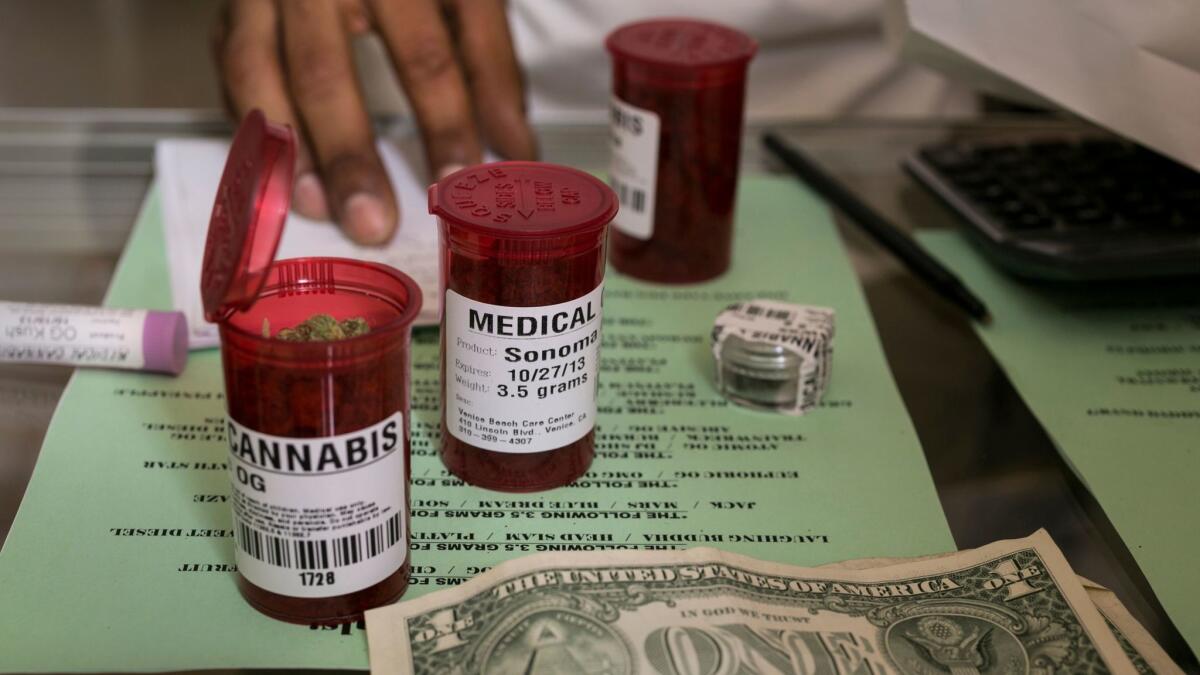Op-Ed: Why I’m still skeptical about legal marijuana in L.A.

- Share via
California is only months away from offering thousands of retailers a license to sell recreational marijuana to people ages 21 or older. It is the will of the voters, yet I remain concerned about the impact that recreational/non-medical cannabis commerce could have on the health and safety of neighborhoods throughout Los Angeles County. I wonder how this “brave new world” will make circumstances, conditions, even life itself better. Currently, all commercial cannabis is banned in the unincorporated areas of the county, and if it were up to me, I’d keep it that way until I felt confident that safeguards were in place to protect our communities.
As things stand, it is imperative that the Board of Supervisors enacts responsible regulation and effective oversight, developed with input from a wide range of stakeholders, to ensure that creating a commercial market for marijuana would not lead to overly negative consequences. We have a responsibility to serve all 10 million residents of the county — not just the voters who said yes to Proposition 64 — particularly minors who don’t have the right to vote but certainly deserve our protection.
Our track record has been less than stellar in getting a handle on establishments that sell dependence-inducing substances. Liquor stores are a common sight in many parts of the county, and bear at least part of the blame for higher rates of addiction, blight, petty and violent crime and diminished opportunities for residents in the immediate vicinity. Because unfettered cannabis commerce can compound those problems and sabotage economic revitalization, we should learn from Colorado and Washington, the first states to legalize recreational marijuana (in 2012).
According to its Department of Revenue, Colorado raked in almost $200 million in taxes in 2016 as marijuana sales hit $1.3 billion. But its Department of Public Health and Environment reported that 6% of pregnant women used marijuana, potentially endangering their unborn children’s health. At least 16,000 children were at risk of being exposed to secondhand marijuana smoke at home.
Early and regular marijuana use is associated with use of other illicit drugs, including cocaine, hallucinogens, prescription opioids and heroin.
Colorado’s Department of Public Health and Environment also found that 1 in 4 adults age 18 to 25 used marijuana in the last month, and 1 in 8 adults used marijuana daily or near daily. It also reported that more than 5% of high school students used marijuana daily or near daily. Weekly cannabis use at such a young age is associated with impaired learning and memory and could lead to psychotic symptoms in adulthood.
In Washington, the AAA Foundation for Traffic Safety found that 17% of fatal crashes in 2014 involved drivers who had recently used marijuana, more than double the percentage before legalization.
Though the perils hysterically alleged in “Reefer Madness” have long been debunked, the Los Angeles County Department of Public Health has found that early and regular marijuana use is associated with use of other illicit drugs, including cocaine, hallucinogens, prescription opioids and heroin.
Moreover, the National Highway Traffic Safety Administration has reported that Los Angeles County fatal crashes involving drivers who tested positive for marijuana began to go up after 1996, increased 360% from 2003 to 2004, maintained an upward trajectory until 2008 before decreasing in 2009, and steadily rose again by 60% from 2010 to 2014. The increases coincided with the passage of the Compassionate Use Act, which legalized medical marijuana; the initiation of the Medical Marijuana ID Card Program; and the decriminalization of possessing 1 ounce or less of marijuana, making it an infraction instead of a misdemeanor.
Los Angeles County’s Office of Cannabis Management is working closely with the Board of Supervisors, various departments and a broad array of stakeholders to develop comprehensive and reasonable ordinances and policies for both medical and recreational marijuana. One of the goals is to create an accountable and safe marketplace for the responsible use of marijuana rather than revel in overstated economic opportunity. Let’s be clear that gangs and cartels operate outside regulation, and dismantling this illegal market operating within saturated communities will be daunting.
Though dispensaries tend to be concentrated in low-income neighborhoods of color, less than 1% are owned by people of color, according to the L.A. County Department of Regional Planning. Apparently, racial and economic discrimination does not stop at the doorstep of the cannabis industry.
Proposition 64 proponents say it will generate tax revenue, business profit and jobs. They also claim that it would improve criminal justice by putting fewer people — historically people of color — in jail for smoking a joint. However, that remains to be seen as disparate treatment is a defining feature of law enforcement in too many communities in L.A. County.
A call for effective oversight should not be misconstrued as an attempt to thwart the will of the people, or to wage a new war on drugs. Instead, as a “card-carrying progressive” I consider it due diligence to ensure that the proliferating sale of marijuana, a mind-altering substance, will not wreak havoc on our neighborhoods, particularly those already beset with many other challenges. We certainly don’t want to make matters worse, and, right now, my concern is that commercial cannabis has the potential to do just that.
Mark Ridley-Thomas is chairman of the Los Angeles County Board of Supervisors and represents the 2nd Supervisorial District.
Follow the Opinion section on Twitter @latimesopinion or Facebook
MORE FROM OPINION
Why I want legal marijuana in my South L.A. district
That puppy in the window may have come from a bad breeder
More to Read
A cure for the common opinion
Get thought-provoking perspectives with our weekly newsletter.
You may occasionally receive promotional content from the Los Angeles Times.








